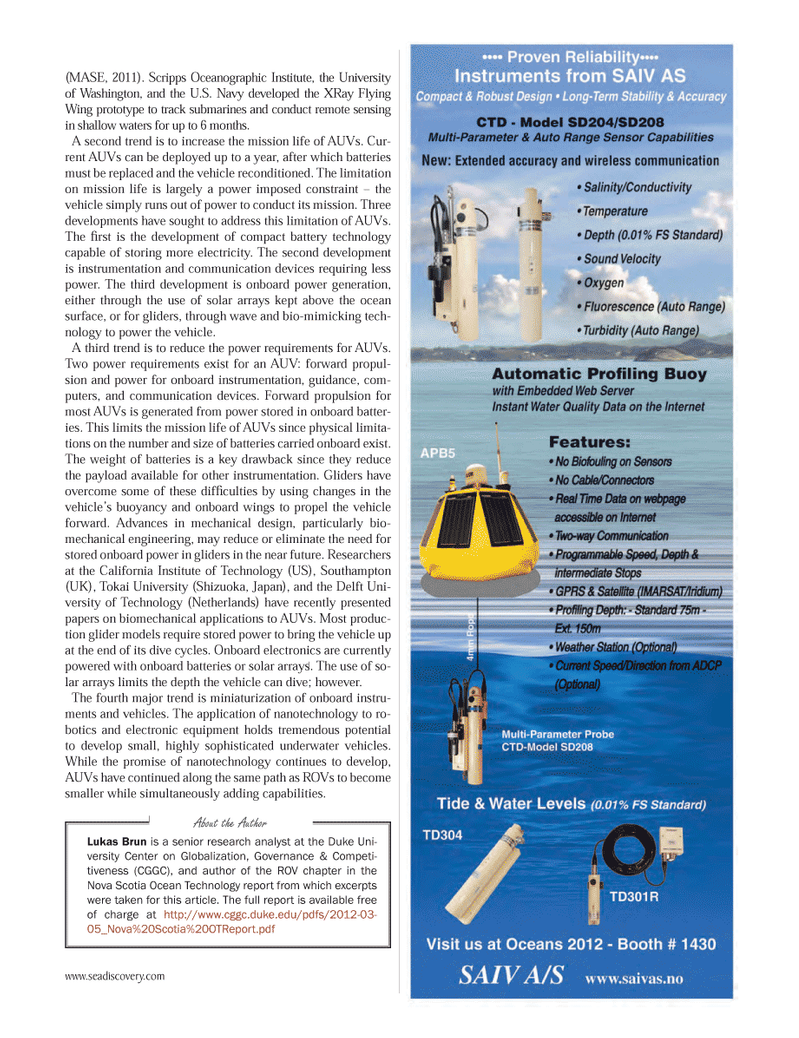
Page 51: of Marine Technology Magazine (September 2012)
Subsea Defense: Protecting Port & Subsea
Read this page in Pdf, Flash or Html5 edition of September 2012 Marine Technology Magazine
(MASE, 2011). Scripps Oceanographic Institute, the University of Washington, and the U.S. Navy developed the XRay Flying Wing prototype to track submarines and conduct remote sensing in shallow waters for up to 6 months. A second trend is to increase the mission life of AUVs. Cur- rent AUVs can be deployed up to a year, after which batteries must be replaced and the vehicle reconditioned. The limitation on mission life is largely a power imposed constraint ? the vehicle simply runs out of power to conduct its mission. Three developments have sought to address this limitation of AUVs. The rst is the development of compact battery technology capable of storing more electricity. The second development is instrumentation and communication devices requiring less power. The third development is onboard power generation, either through the use of solar arrays kept above the ocean surface, or for gliders, through wave and bio-mimicking tech- nology to power the vehicle. A third trend is to reduce the power requirements for AUVs. Two power requirements exist for an AUV: forward propul- sion and power for onboard instrumentation, guidance, com- puters, and communication devices. Forward propulsion for most AUVs is generated from power stored in onboard batter- ies. This limits the mission life of AUVs since physical limita- tions on the number and size of batteries carried onboard exist. The weight of batteries is a key drawback since they reduce the payload available for other instrumentation. Gliders have overcome some of these dif culties by using changes in the vehicle?s buoyancy and onboard wings to propel the vehicle forward. Advances in mechanical design, particularly bio- mechanical engineering, may reduce or eliminate the need for stored onboard power in gliders in the near future. Researchers at the California Institute of Technology (US), Southampton (UK), Tokai University (Shizuoka, Japan), and the Delft Uni- versity of Technology (Netherlands) have recently presented papers on biomechanical applications to AUVs. Most produc- tion glider models require stored power to bring the vehicle up at the end of its dive cycles. Onboard electronics are currently powered with onboard batteries or solar arrays. The use of so- lar arrays limits the depth the vehicle can dive; however. The fourth major trend is miniaturization of onboard instru-ments and vehicles. The application of nanotechnology to ro- botics and electronic equipment holds tremendous potential to develop small, highly sophisticated underwater vehicles. While the promise of nanotechnology continues to develop, AUVs have continued along the same path as ROVs to become smaller while simultaneously adding capabilities. About the AuthorLukas Brun is a senior research analyst at the Duke Uni- versity Center on Globalization, Governance & Competi- tiveness (CGGC), and author of the ROV chapter in the Nova Scotia Ocean Technology report from which excerpts were taken for this article. The full report is available free of charge at http://www.cggc.duke.edu/pdfs/2012-03- 05_Nova%20Scotia%20OTReport.pdf www.seadiscovery.com MTR #7 (50-64).indd 51MTR #7 (50-64).indd 519/10/2012 10:16:35 AM9/10/2012 10:16:35 AM

 50
50

 52
52
